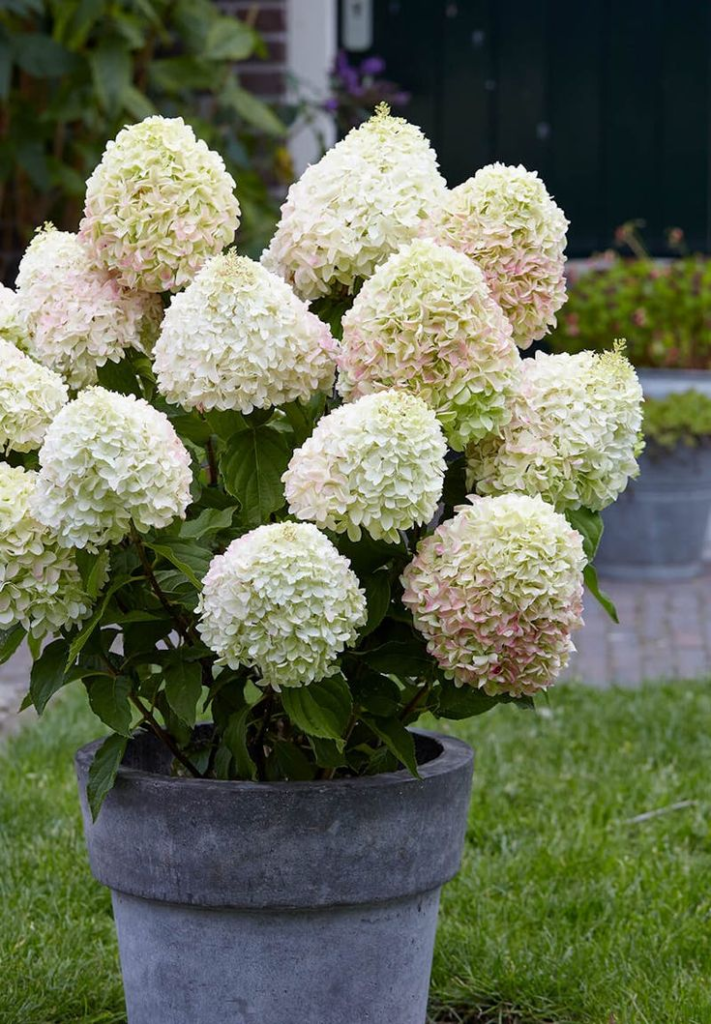Hydrangeas are beloved for their stunning blooms and lush foliage, making them a favorite among gardeners.

With their vibrant colors and varying sizes, hydrangeas can be a focal point in any garden.
To help you grow these beautiful plants with confidence, we’ve compiled five easy tips.
Whether you’re a seasoned gardener or a beginner, these tips will guide you towards a flourishing hydrangea garden.
Understanding Hydrangeas
Types of Hydrangeas
There are several types of hydrangeas, each with its own unique characteristics:
Hydrangea macrophylla (Bigleaf Hydrangea): Known for their large, mophead or lacecap blooms.

Hydrangea paniculata (Panicle Hydrangea): Features cone-shaped flower clusters.

Hydrangea arborescens (Smooth Hydrangea): Produces large, white blooms.

Hydrangea quercifolia (Oakleaf Hydrangea): Recognizable by its oak-shaped leaves and white flowers.

Climate and Hydrangeas
Hydrangeas thrive in temperate climates but can adapt to various conditions. Understanding your local climate will help you choose the right hydrangea variety for your garden.
1. Choosing the Right Location
Optimal Sunlight
Hydrangeas generally prefer morning sun and afternoon shade. Too much direct sunlight can cause wilting, while too little can hinder blooming.
Soil Requirements
Hydrangeas thrive in well-drained, fertile soil. They prefer slightly acidic to neutral pH levels. Conduct a soil test to determine your soil’s pH and amend it if necessary.
2. Planting Hydrangeas
When to Plant
The best time to plant hydrangeas is in spring or fall, when temperatures are moderate.
Spacing and Depth
Plant hydrangeas at the same depth they were in their nursery pots. Space them according to the mature size of the variety, ensuring adequate air circulation.
3. Watering Hydrangeas
Consistent Moisture
Hydrangeas need consistent moisture, especially during the first year after planting. Water deeply once or twice a week, depending on rainfall and soil type.

Mulching
Apply a 2-3 inch layer of mulch around the base of the plant to retain moisture and regulate soil temperature. Avoid piling mulch against the stem.
4. Pruning Hydrangeas
When to Prune
Pruning time depends on the type of hydrangea. Bigleaf and oakleaf hydrangeas bloom on old wood and should be pruned after flowering.
Panicle and smooth hydrangeas bloom on new wood and can be pruned in late winter or early spring.

Pruning Techniques
Remove dead or diseased wood and cut back old flowering stems. For new wood bloomers, prune to shape and encourage new growth.
5. Feeding Hydrangeas
Fertilization Schedule
Fertilize hydrangeas in spring and mid-summer with a balanced, slow-release fertilizer. Avoid over-fertilizing, as this can lead to excessive foliage at the expense of blooms.
Adjusting Bloom Color
For Bigleaf Hydrangeas, bloom color can be influenced by soil pH. Acidic soil (pH below 6) produces blue flowers, while alkaline soil (pH above 7) results in pink flowers. Use soil amendments to adjust the pH and achieve the desired color.
Common Issues and Solutions
Pest Control
Hydrangeas are relatively pest-free, but they can occasionally suffer from aphids, spider mites, or scale. Use insecticidal soap or neem oil to manage infestations.
Disease Prevention
Fungal diseases like powdery mildew and leaf spot can affect hydrangeas. Ensure good air circulation, avoid overhead watering, and apply fungicides if necessary.
Winter Protection
Preparing for Winter
In colder climates, protect hydrangeas from harsh winter conditions. Apply a thick layer of mulch and consider covering the plants with burlap or garden fabric.
Overwintering Potted Hydrangeas
Move potted hydrangeas to a sheltered location or indoors during winter to prevent root freeze.
Companion Planting
Best Companion Plants
Plant hydrangeas with companions that have similar growing requirements, such as hostas, ferns, and shade-loving perennials.
Avoiding Competition
Ensure companion plants don’t compete with hydrangeas for water and nutrients. Maintain appropriate spacing to promote healthy growth.
Conclusion
Growing hydrangeas can be a rewarding experience, providing your garden with beautiful blooms and lush foliage.
By following these five easy tips—choosing the right location, planting properly, watering consistently, pruning correctly, and feeding appropriately—you’ll be well on your way to cultivating stunning hydrangeas.
Remember to monitor for pests and diseases, protect your plants in winter, and consider companion planting to enhance your garden’s beauty.
With a little care and attention, your hydrangeas will thrive and bring joy to your garden for years to come.
FAQs
1. How often should I water my hydrangeas?
Water hydrangeas deeply once or twice a week, depending on rainfall and soil type. Consistent moisture is key, especially during the first year after planting.
2. Can I change the color of my hydrangea blooms?
Yes, you can influence the bloom color of Bigleaf Hydrangeas by adjusting the soil pH. Acidic soil produces blue flowers, while alkaline soil results in pink flowers.
3. When is the best time to prune hydrangeas?
Pruning time depends on the type of hydrangea. Bigleaf and oakleaf hydrangeas should be pruned after flowering, while panicle and smooth hydrangeas can be pruned in late winter or early spring.
4. What should I do if my hydrangeas are not blooming?
Ensure your hydrangeas are receiving the right amount of sunlight and water. Check soil fertility and pH levels, and prune correctly.
Avoid over-fertilizing, as this can lead to excessive foliage at the expense of blooms.
5. How can I protect my hydrangeas in winter?
In colder climates, protect hydrangeas by applying a thick layer of mulch and covering the plants with burlap or garden fabric. Move potted hydrangeas to a sheltered location or indoors to prevent root freeze.